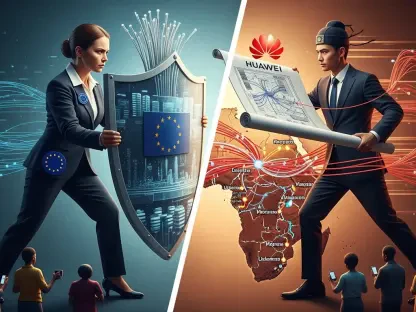Unraveling a High-Stakes Dispute in a Saturated Market
Imagine a telecom market so tightly packed that 6.1 million people support a staggering 9.7 million mobile subscriptions, creating an arena where every competitive move is magnified. This is the reality in Singapore, where a rare legal battle between Circles.Life, a mobile virtual network operator (MVNO), and M1, a major telecom player, has erupted, sending ripples through an industry shaped by state influence and intense rivalry. This market analysis delves into the implications of this dispute, examining how it reflects deeper tensions in MVNO-MNO relationships and intersects with broader trends like market consolidation. The purpose is to uncover what this clash means for competitive dynamics, regulatory oversight, and future innovation in one of Asia’s most connected city-states. By dissecting current patterns and projecting potential outcomes, this examination aims to provide clarity on a pivotal moment for stakeholders across the sector.
Deep Dive into Market Trends and Competitive Pressures
Legal Friction as a Symptom of Structural Imbalance
Singapore’s telecom landscape, dominated by three major operators—Singtel, StarHub, and M1—operates under the significant influence of Temasek, the state investment arm with substantial stakes in these entities. The lawsuit filed by Liberty Wireless, the parent company of Circles.Life, against M1 over a 2019 network access agreement highlights a rare public fracture in this tightly controlled environment. The core allegation centers on M1’s alleged refusal to negotiate amendments in good faith, with claims of a possible contractual error prompting Circles.Life to seek judicial intervention. This dispute underscores a structural imbalance where MVNOs, reliant on larger operators for infrastructure, often face limited bargaining power in a market with few network hosts to choose from.
This legal confrontation is not merely a bilateral issue but a signal of underlying vulnerabilities for smaller players. With a population base that restricts the number of viable MNO partners, MVNOs like Circles.Life must navigate a dependency that can stifle growth or innovation if agreements falter. Industry observers note that such friction, while uncommon due to state oversight, could set a precedent for how network access contracts are drafted and enforced moving forward. The outcome of this case may either empower smaller entrants or reinforce the dominance of established operators, shaping the competitive hierarchy in subtle but lasting ways.
Consolidation Wave: The M1-Simba Merger in Focus
Adding complexity to the legal drama is the timing of M1’s merger with Simba Telecom, Singapore’s smallest MNO, controlled by Australia’s TPG Telecom unit, Tuas. Announced earlier this year, the deal involves Keppel Ltd. selling its 84% stake in M1 for 1.0 billion Singapore dollars (approximately US$770 million), while retaining key ICT assets like data centers. This consolidation move reflects a broader trend in a saturated market, where operators seek to pool resources to shift focus from price wars to investments in digital infrastructure. Keppel has asserted that the lawsuit will not derail the merger, yet the overlap raises questions about M1’s strategic priorities during this transition.
The merger’s implications extend beyond M1’s immediate future, potentially altering the dynamics for MVNOs like Circles.Life. A combined entity might prioritize different operational goals, which could affect existing network access agreements. Market analysts suggest that consolidation often strengthens larger players, enabling them to fund cutting-edge technologies like 5G at a scale smaller operators struggle to match. This trend, while potentially beneficial for overall industry health, risks marginalizing MVNOs unless contractual protections are robustly upheld, a concern likely fueling Circles.Life’s urgency in pursuing legal clarity at this juncture.
Innovation Over Price: Shifting Competitive Paradigms
Beyond legal and structural shifts, Singapore’s telecom sector is witnessing a pivot in competitive strategy, moving away from relentless price undercutting toward innovation-driven growth. Budget brands like Singtel’s GoMo and StarHub’s Eight have intensified low-cost competition, yet industry sentiment, including from Circles.Life’s leadership, supports the M1-Simba merger as a catalyst for healthier rivalry focused on technological advancement. The push for 5G adoption and enhanced digital services is becoming a priority, as operators recognize that a saturated market demands differentiation beyond mere affordability.
This strategic realignment carries significant projections for the next few years, from 2025 to 2027, with expectations that consolidated entities will lead investments in next-generation networks. Smaller players, however, must adapt swiftly to avoid being sidelined, potentially leveraging niche offerings or agile business models to carve out relevance. The challenge lies in balancing profitability with innovation, especially for MVNOs whose operational constraints limit their investment capacity. If successful, this shift could elevate service quality across the board, benefiting consumers with more robust and diverse telecom solutions.
Regulatory and Relational Dynamics Under Scrutiny
Another critical trend illuminated by this dispute is the complex interplay between regulation and commercial relationships in Singapore’s telecom ecosystem. While state influence through Temasek often mitigates public conflict, it does not erase underlying tensions between MVNOs and MNOs. The dependency of smaller operators on a limited pool of network providers creates a power dynamic that can stifle fair negotiation, a vulnerability now exposed through the ongoing lawsuit. This situation prompts a closer look at whether current regulatory frameworks adequately protect smaller entrants in such a concentrated market.
Projections indicate that regulatory bodies might respond to this clash by refining guidelines for network access agreements, ensuring clearer terms to prevent similar disputes. Such changes could encourage more MVNOs to enter the market, fostering diversity in offerings, though they might also burden MNOs with stricter partnership obligations. The balance between encouraging competition and maintaining industry stability will be pivotal, as overly stringent rules could deter infrastructure investment by larger players. This evolving dynamic suggests a market at a crossroads, where policy decisions in the coming years could redefine operational norms.
Reflections and Strategic Pathways Forward
Looking back, the analysis of the Circles.Life-M1 legal battle reveals a telecom market grappling with rare public friction, structural dependencies, and a transformative push toward consolidation. The examination of trends like the M1-Simba merger underscores a strategic realignment aimed at bolstering digital infrastructure, while the shift from price wars to innovation paints a picture of an industry seeking sustainable growth. These findings highlight the delicate balance between empowering smaller players and enabling larger operators to drive technological progress in a saturated environment.
For stakeholders, the next steps involve prioritizing transparent and resilient contracts to mitigate the risk of disputes, with MVNOs advised to embed legal safeguards in agreements and MNOs urged to foster equitable partnerships. Policymakers face the task of crafting frameworks that support both competition and investment, ensuring that market consolidation does not come at the expense of diversity. As the sector continues to evolve, businesses and consumers alike need to monitor how these legal and strategic shifts influence service landscapes, advocating for clarity and fairness in an industry where every decision echoes loudly.









